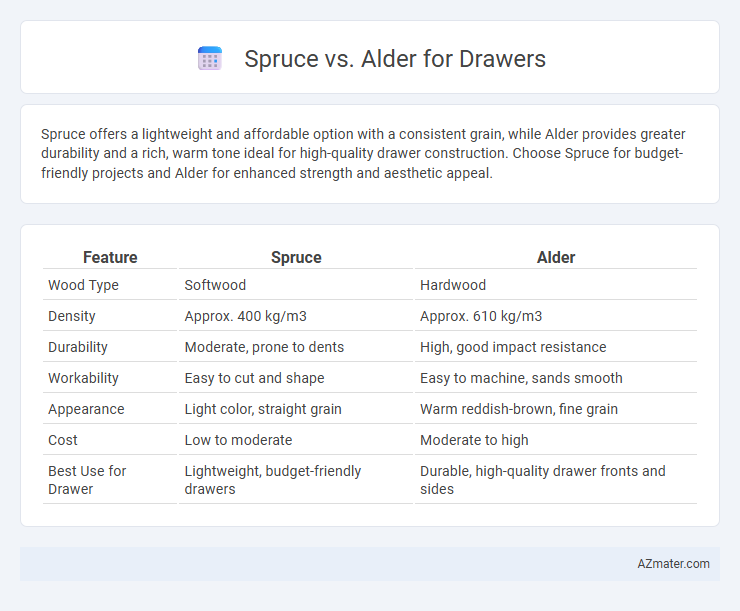Spruce offers a lightweight and affordable option with a consistent grain, while Alder provides greater durability and a rich, warm tone ideal for high-quality drawer construction. Choose Spruce for budget-friendly projects and Alder for enhanced strength and aesthetic appeal.
Table of Comparison
| Feature | Spruce | Alder |
|---|---|---|
| Wood Type | Softwood | Hardwood |
| Density | Approx. 400 kg/m3 | Approx. 610 kg/m3 |
| Durability | Moderate, prone to dents | High, good impact resistance |
| Workability | Easy to cut and shape | Easy to machine, sands smooth |
| Appearance | Light color, straight grain | Warm reddish-brown, fine grain |
| Cost | Low to moderate | Moderate to high |
| Best Use for Drawer | Lightweight, budget-friendly drawers | Durable, high-quality drawer fronts and sides |
Introduction to Spruce and Alder Wood
Spruce is a lightweight softwood known for its straight grain, pale color, and excellent strength-to-weight ratio, making it a popular choice for lightweight drawer construction. Alder wood, a hardwood with a reddish-brown hue and fine, even texture, offers durability and smooth finishing qualities ideal for drawers requiring a more refined appearance. Both woods provide unique benefits in drawer making, with spruce favoring strength and lightness, while alder excels in aesthetic appeal and sanding quality.
Physical Characteristics: Spruce vs Alder
Spruce features a light color with a straight grain and a fine, even texture, making it a softwood that is relatively lightweight but less durable compared to hardwoods. Alder is a hardwood exhibiting a warm, reddish-brown hue with a smooth, uniform grain and medium density, offering greater strength and resistance to dents and wear. The physical characteristics of alder make it more suitable for drawers that require durability and a refined finish, while spruce is often chosen for budget-conscious projects where lighter weight is preferred.
Strength and Durability Comparison
Spruce wood offers moderate strength and is lightweight but less durable compared to alder, making it more prone to dents and wear in high-traffic drawer applications. Alder, known for its higher density and hardness, provides superior strength and long-lasting durability, resisting scratches and impacts better over time. For drawer construction requiring robust performance and longevity, alder is generally the preferred choice due to its enhanced structural integrity and resistance to daily use.
Workability and Ease of Machining
Spruce offers excellent workability due to its lightweight and uniform grain, making it easier to cut and shape for drawer construction. Alder, known for its fine, consistent texture, machines smoothly with minimal resistance, yielding clean edges and reducing tool wear. Both woods provide favorable workability, but alder's denser composition enhances durability while maintaining ease of machining.
Aesthetic Appeal and Grain Patterns
Spruce offers a light, pale hue with a uniform, straight grain that creates a clean and minimalist aesthetic ideal for modern drawer designs. Alder features a warm, reddish-brown tone with a more pronounced and varied grain, adding character and a rustic charm to drawer fronts. Choosing between spruce and alder for drawers depends on whether a subtle, contemporary look or a distinctive, natural texture is preferred for the furniture piece.
Weight and Density Differences
Spruce is significantly lighter than alder, with a density ranging from 350 to 450 kg/m3 compared to alder's 560 to 640 kg/m3, making spruce ideal for lightweight drawer construction. The lower density of spruce results in easier handling and less strain on furniture hardware, while alder's higher density provides greater durability and resistance to dents. Choosing between spruce and alder for drawers depends on balancing the need for lightweight ease versus durability and strength.
Cost Effectiveness and Market Availability
Spruce offers superior cost effectiveness for drawer construction due to its lower price per board foot compared to alder, making it ideal for budget-conscious projects. Alder, while more expensive, provides a smoother finish and better workability, though its higher market demand can limit availability in some regions. Spruce's widespread availability in North American lumber suppliers ensures easier sourcing and consistent supply for large-scale drawer manufacturing.
Best Uses: When to Choose Spruce or Alder for Drawers
Spruce is ideal for lightweight drawers and applications requiring a fine, smooth surface due to its straight grain and soft texture, making it perfect for painted finishes and budget-conscious projects. Alder offers greater durability and a natural warm tone with subtle grain patterns, making it suitable for high-use drawers that benefit from a refined, rustic appearance. Choose spruce for affordability and ease of finishing, while alder excels in strength and aesthetic appeal for long-lasting, decorative cabinetry.
Environmental Impact and Sustainability
Spruce offers a lower environmental impact due to its rapid growth rate and widespread availability, making it a highly renewable resource for drawer construction. Alder, while slower growing, is often harvested from sustainably managed forests, with a focus on preserving biodiversity and soil quality. Both woods can support sustainable practices, but spruce's quicker replenishment cycle generally makes it a more eco-friendly choice for environmentally conscious furniture.
Final Verdict: Which Wood is Better for Drawers?
Spruce offers a lightweight and cost-effective option for drawer construction, featuring moderate strength and ease of finishing suitable for light to medium-duty use. Alder provides superior durability, a finer grain, and a smoother finish, making it ideal for drawers that require higher resilience and aesthetic appeal. For drawers expected to withstand frequent use and provide a polished appearance, alder wood is the better choice.

Infographic: Spruce vs Alder for Drawer
 azmater.com
azmater.com